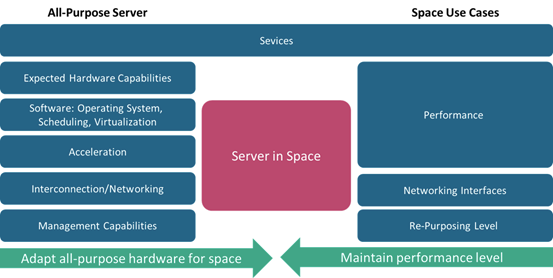
-
StatusOngoing
-
Status date2023-08-16
-
Activity Code5A.080
Earlier in terrestrial communication and computer networks generic multi-purpose servers brought an extremely high economy of scale through drastic reduction of production costs and the increased flexibility offered. However, if we try to replicate this success in the space environment for the provision of future space services a common hardware would not suffice, additional dedicated peripherals are required. As such, to be able to provide and utilise a Server in Space (SiS) the trade-offs between the capabilities that can be re-used for different services, starting from a generic all-purpose server, and the level of performance expected by the space use cases, until now provided through dedicated designs shall be considered, studied and analysed.

To be able to reach the SiS economy of scale the system must be able to address and to optimize for very diverse existing, as well as new use cases that have a high potential. This includes the potential local processing of Earth Observation data use cases (e.g. radar) as well as new 5G and beyond 5G Non-Terrestrial Networks (NTN), including short path communication using Multi-Access Edge Computing (MEC), local applications (e.g. voice over NTN) and the emerging joint communication and sensing (JCAS). Currently, these use cases either rely on dedicated hardware or are not yet deployed in space nodes.
The ambition of 5GEOSiS is to support this evolution through the provision of a suitable hardware test-bed and initial trade-off studies.
In general, the biggest challenge for the project is that the concepts for space-based Joint Processing and Communication and Integrated Sensing and Communications are not yet very mature making it difficult to assess the benefit and value of sharing of parts (e.g. frequency up-/down-conversion) or all (including the antenna) of the RF Tx/Rx chain between 5G communications and RF sensing. Within this main challenge there is a clear issue regarding the limited (rather low) capacity of compute elements, and the critical aspect of interfacing with the peripheral elements.
Concerning the fundamental aspect of sharing resources, the project plans to use practices and solutions already proven in terrestrial networks.
The management of the repurposing and the actual solution adopted needs to be optimised for the expected intervals between repurposing.
Last, but certainly not least, solutions for the actual sharing of and repurposing mechanisms regarding certain hardware components, especially antennas, amplifiers and DSPs in the context of ISAC are something to be developed.
The main benefit of 5GEOSiS is the support for the creation of a common platform, a server in space that can be repurposed.
Ultimately, 5GEOSiS provides a HW platform, a test-bed for experimenting and validating Joint Processing and Communication concepts and approaches - a server in space that can be dynamically repurposed. This is an entirely new area, certainly in the space environment concerning satellite payloads.
The HW test-bed addresses the combination of communication and sensing. A number of distinctive levels of integration of communication and sensing can be distinguished, of which the targeted Joint Communication and Processing represents an intermediate stage that is realistic to be implemented.
Features of the Joint Communication and Processing:
-
It relies on the full (regenerative) gNB being implemented in the satellite payload;
-
EO payload communications (both TM/TC and Data traffic) can be handled by the 5G payload;
-
Includes the provision of full processing services also for the EO payload thus enabling novel use cases and application scenarios;
-
Requires the implementation of a regenerative processing (and most likely also storage) unit that also conducts the required / requested processing on EO raw data. In that sense this is the first truly repurposable 5G payload concept;
-
Depending on the computing power of the processing unit it can operate in simultaneous, time-interleaved/-multiplexing or –switching mode.
The HW test-bed will rely on and feature of the following:
-
Software: Fraunhofer FOKUS Open5Gcore + Fraunhofer FOKUS NMS + OAI running in a Debian environment.
-
Connections / connectivity:
-
5GNTN radio implemented using an USRP SDR interfacing towards the test-bed over Ethernet;
-
(up to 4) cameras connected through an FMC to 4x PMOD Adapter;
-
simulated digital feeds: feeder link, (RF Antenna) DVB, RADAR data fed by a simulation server.
-
In the diagram below we provide a schematic depiction of a generic all purpose Server in Space.

The 5GEOSiS activities are organised in two parallel strands as depicted below.

The WP1-WP4 strand focuses on Joint Processing and Communication (JPAC), whilst the parallel WP5-WP6 strand focuses on the Integrated Sensing and Communication (ISAC).
5GEOSiS plans with four milestones.
-
Milestone 1 is the System Requirements Review regarding JPAC and the Critical Design Review of the Test-bed and is scheduled for month 5.
-
Milestone 2 is the Critical Design Review concerning JPAC, the Test Readiness Review concerning the test-bed and the System Requirements Review concerning the Integrated Sensing and Communication, and is scheduled for month 9.
-
Milestone 3 is the Test-bed validation review and the Critical Design Review concerning ISAC, and is scheduled for month 14.
-
Milestone 4 is the Final Review and is scheduled after completing the activities by the end of month 15.
The 5GEOSiS project started in July 2023. Initial activities most notably include the organisation of a workshop in September 2023 with a specific focus on Joint Processing and Communication.



